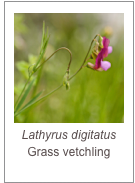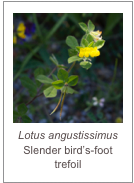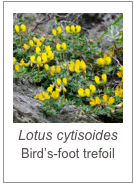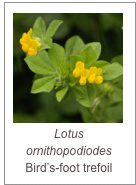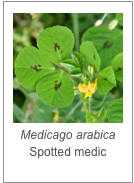The Wild Flowers of Skopelos
Blog
For those who love Skopelos and the wildflowers of Greece
The Wild Flowers of Skopelos
Blog
For those who love Skopelos and the wildflowers of Greece


















Now more than 300 flowers and trees

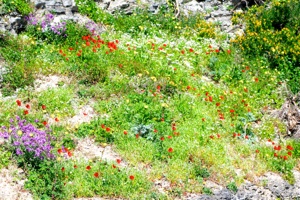
The Wildflowers of Skopelos is for those who love the island of Skopelos and the wildflowers of Greece.
There are now over 300 flowers and trees and also information on the island, its floral landscape, geology, climate, and ecological habitats.
A Cool Woodland Glade
23 Aug 2020
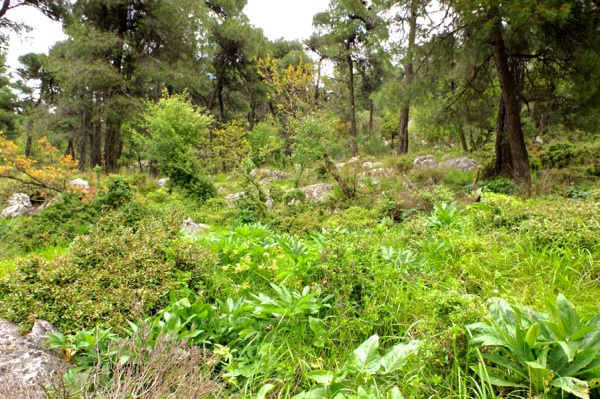
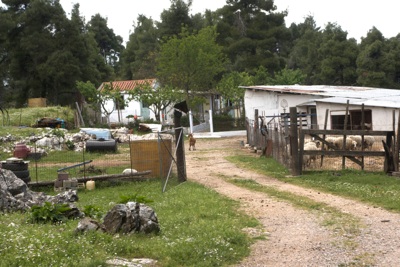
Goats are often criticised by botanists as destroyers of plants and the landscape, but when kept in balance, as they are Skopelos, they can create a valuable ecological niche, adding another patch to the mosaic of habitats of the complex Mediterranean ecosystem.
Many of the plants which dominate the patch at different times of the year are obviously not favoured foods of the sheep and goats, including hellebores (Helleborus odorus), dragon flowers (Dracunculus vulgaris), oregano (Origanum vulgare) and spearmint (Mentha spicata). Phrygana species, pink and white rock rose (Cistus creticus & C. salvifolius) and evergreen oaks (Quercus coccifera and Q. ilex) are trimmed into low bushes and between them many grassland species abound: the inconspicuous corn salad (Valerianella discoidea); the bedstraw, field madder (Sherardia arvensis) with its tiny pale pink flowers, the attractive pea flowers (Lathyrus digitatus); several species of geranium family and many more. The simple white woodland daisies (Bellis sylvestris) are scattered throughout the area in autumn and early spring and chamomile flowers later in the year. Many plants flower later and last longer in the cool, moist surroundings of the glade than on other more exposed parts of the island.
Five new plants added, all found in the forest glade





Aromatic Herbs
16 Jun 2020
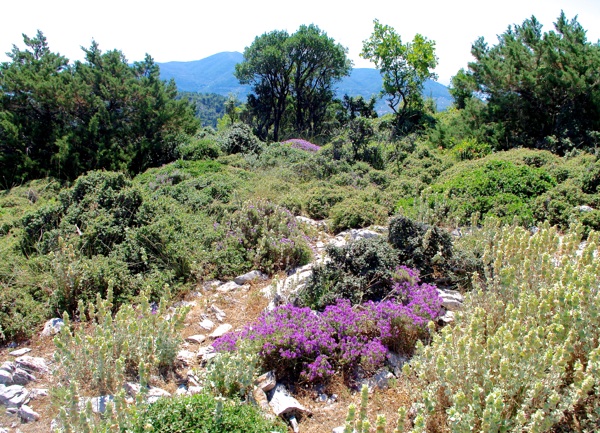
As we enter the summer months, the green grasses turn to gold and many of the brightly coloured flowers which are scattered across the island in spring begin to fade and die back. The plants generally regarded as typical Mediterranean herbs become more dominant, filling the air with their spicy fragrance. These plants do not produce their seeds and complete their life cycles before the summer and do not not die back to exist only underground as bulbs, corms or rhizomes as many other plants do but remain in leaf throughout the hottest months, protecting themselves from heat, drought and high light levels by special adaptations. They are often low growing compact shrubs with thickened leaves (sclerophyls), with a thick cuticle and are often covered in hairs giving them a grey or silver appearance. The plants contain volatile aromatic oils, which are emitted by the leaves forming a barrier to water loss and protecting from heat and light. The plants contain essential oils and are valued for culinary or medicinal uses.
They may be coming to the end of their flowering time but on a country walk you may still see the delightful French lavender, Lavandula stoechas, with their plumes of purple bracts and the bright purple flower heads of thyme, Thymbra capitata, so attractive to butterflies, which shine out amongst the grey foliage of Ballota acetabulosa in dry stony places.
Many of these plants, including sages, thymes, wild basil and lemon balm belong to the mint family; but others are unrelated: the rock roses (Cistus creticus & C. salvifolius), St. John’s wort (Hypericum empetrifolium) and Plocama calabrica, but they have all evolved similar protective characteristics in response to environmental constraints.
Many of these herbs are collected by the Skopelitians: oregano (Origanum vulgare) to flavour meat or to be scattered on salads, St. John’s wort (Hypericum perfolium) to make an antiseptic tincture, sage and thyme to make country teas and feverfew leaves for prevention of migraine.
These plants often grow together particularly in dry calcarious environments forming plant communities known as phrygana or hedgehog heath: the typical coastal habitat of many Greek islands.
Three new plants added, all flower in late spring or early summer.



The Bee Orchids
Οφρύς
18 May 2020
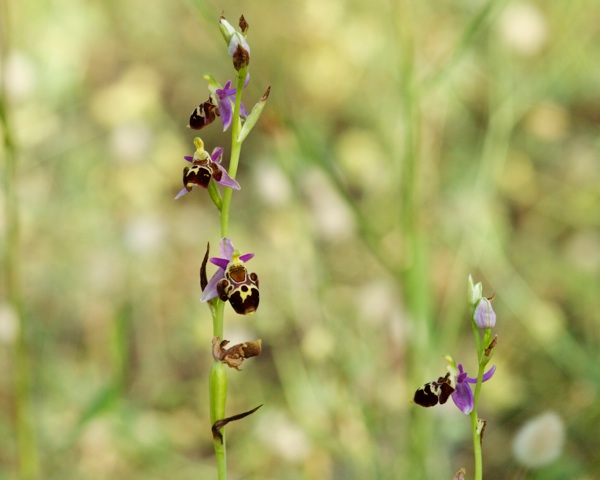
When I imagine Skopelos in the month of May, I always think of the orchids, with their beautiful complex flowers. They have fascinated generations of botanists, including Darwin, who published a book, “ On the various contrivances by which British and foreign orchids are fertilised by insects” in which he describes the detailed structure and the function of their parts.
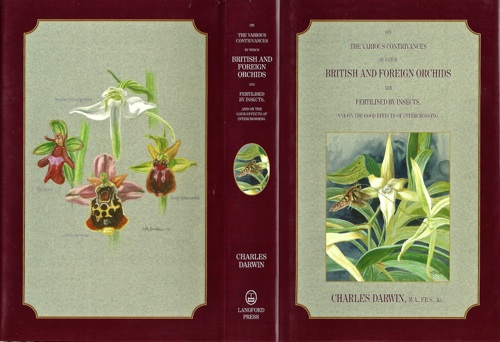
More recently genetic studies have clarified their origin, evolution and diversification: the Orchids are an ancient floral family, which originated more than 66million years ago, around the time of the dinosaurs but as a result of a genetic mutation, survived the mass extinction event which obliterated most life forms on earth. The survivors rapidly diverged into five subfamilies from which the 30.000 species of orchids which exist today have evolved.
Particularly intriguing are the flowers of the Ophrys genus: the bee orchids, which are represented by eight species on the island of Skopelos. The bee orchids have evolved to attract insects in order to effect cross fertilisation, not like most flowers, by the promise of food in the form of pollen or nectar but by sexual mimicry. The flowers are visited by only male insects, enticed by the chemical odour, which simulates the pheromones produced by the females. The large lower lip of the orchid, visually and tactilely, resembles a female of the species or a female resting on a petal (O. lutea). He will mount the flower performing an activity known as pseudocopulation; as a result the small pollen packages, pollinia attach to the back of the head or body of the insect and and is transferred to another flower effecting fertilisation. The idea of each bee orchid having a special relationship with one species of bee is, of course simplistic and some orchids, such as the sawfly orchid, are visited by a variety of hymenoptera (bees and wasps) and a number of different moths, although only some of the visitors are successful pollinators. The bumble bee orchid is only pollinated by solitary mining bees (Androphora species). One species of bee orchid, the common Ophrys apifera, is able to pollinate its own flowers. If the pollinia have not been transferred by a bee and remain on the flowers its supporting stalk curves over until it touches its own sticky stigma, the female part of the flower an act of self fertilisation or autogamy.
Many of the bee orchids species have names not based on the insect species it is pollinated by but that which it resembles to the imaginative human eye: Ophrys bombiliflora - the bumble bee orchid, O. tenthredinfera - the sawfly orchid, one is named after a brightly coloured bird O. scolpax - the woodcock orchid; and one with a circular spot on the lip, O umbilicata; all these can be found, if you are lucky, on Skopelos.








See also earlier blog:
And more orchids on Kjell Thovsen’s site Skopelos Flora
including the beautiful Butterfly orchid.
A certain magical place
Συγκεκριμένο μαγικό μέρος
16 April 2020
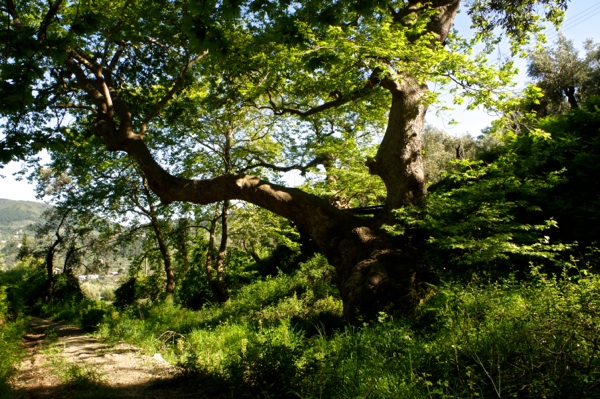
The foliage of a huge ancient plane tree, Platanus orientalis, produces deep dappled shade, creating a magical place, where a cool stream runs from a crystal clear spring. Each evening a shepherd with his dogs and donkeys brings down his sheep from the sun drenched slopes above, continuing a tradition which has continued on the island for centuries past.
A unique climate has been created with its own special array of plants. Growing on the mossy edge of the rivulet is a green fringe of the beautiful lacy maidenhair fern (Adiantum capillus-veneris) and amongst the ferns, the delicate white flowers of brookweed (Samolus valerandi) and, in the rich moist ground, lesser loosestrife (Lythrum hyssopifolia), with its pretty pink flowers, a common pioneer of bare mud. Also taking advantage of the cool shade and rich soil is the climbing plant black bryony.
A delightful escape on a hot summers day - but don’t tell everyone.





Looking forward to summer
Ο φλεβάρις κι αν Φλεβίσει, καλοκαίρι θα μυρίσει
16 April 2020
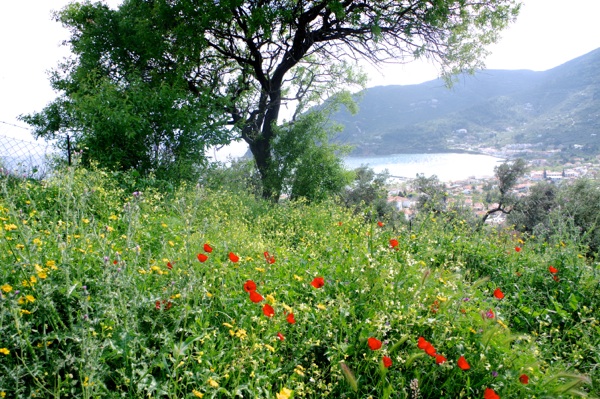
The popular Greek saying; “O flevaris ki an flevisi, kalokari tha mirisi”, means that although February brings bad weather, the scent of summer is in the air. It is the time for looking forward to the warmer weather when there is an explosion of wildflowers of every colour scattered across the island of Skopelos. The new flowers added to the website were all photographed in spring or early summer of recent years.
They are not related to each other and all belong to different plant families.


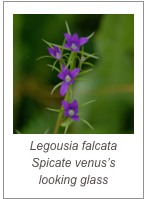
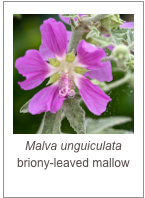
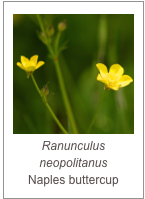
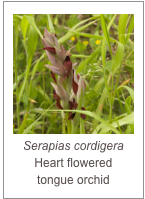
The Fabaceae
The Bean and Pea Family
10 Jan 2020
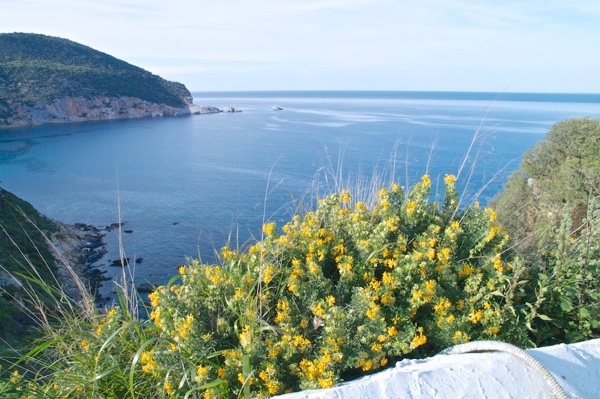
Tree Medic Medicago arborea
The Fabaceae family, also known as Leguminosae or simply as the pea and bean or legume family; it is the third largest plant family after the Orchid (Orchidaceae) and daisy (Asteraceae) families. The Fabaceae occur as trees, shrubs and herbaceous plants and are found on every continent except Antartica. The plants of the Fabaceae are particularly important in the Mediterranean ecosystem, where soils are often dry and poor in nitrogen.
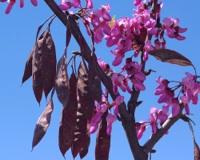
The defining characteristic of the family is the fruit, which is always a pod, sometimes simple as for Lathyrus peas and Vicia species, coiled as for the medics or curious spiny pods of Onobrychis species. It is often the seed pods which help identifying a specific species.
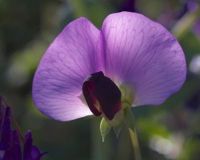
The flowers of the largest subfamily are bilaterally symmetrical ( zygomorphic), the typical pea flower; they are often brightly coloured and said to resemble butterflies hence the name Papillonaceae.
The Fabaceae are economically important providing valuable highly nutritious foods which are rich in protein including lentils, peas and an assortment of beans, important in the Greek culinary tradition. Their use as foods goes back to ancient times with evidence of the cultivation of peas and lentils in Neolithic Greek settlements and it is probable that the seeds of wild peas were collected and eaten before this. In Santorini the seeds of Lathyrus clymenum, a plant which grows wild on Skopelos, are used to make the special Santorini Fava. The plants are also valued as animal fodder, constituents of animal pastures and hay and are also used to fertilise the ground as green manure and in crop rotation.The flowers are attractive to bees and support honey production.
On Skopelos there are about 100 species of Fabaceae, ranging from the common white clover, Trifolium repens, which is distributed widely throughout the world; to the relatively rare Malcolmia macrocalyx ssp. macrocalyx found only on the islands of North and West Aegean. Some plants such as the narrow-leaf lupin (Lupinus angustifolia) may be grown in gardens, but others, such as hairy vetch (Vicia villosa) may act as troublesome agricultural weeds. Trees include the carob, with its edible pods, the Judas tree, with its clusters of brilliant pink flowers and Colutea arborescens, with curious papery pods. The shrubs which explode with yellow blossoms in early summer are mostly Fabaceae and a variety of herbaceous plants: clovers, medics, lotus and vetches all belong to this family as well as a variety of wild peas, including Pisum sativum, a predecessor of the modern pea, which can be found scrambling through the long grass.
Nitrogen fixation
Bacteria from the soil, known as rhizobia, infect the roots of the Fabaceae, where they multiply sometimes developing nodules. The bacteria take up nitrogen from the atmosphere and convert it to nitrogenous compounds such as ammonia, which can be used by the plants to form amino acids and proteins - the process is referred to as nitrogen fixation. As well as using these compounds for there own growth and development, an excess of nitrogenous compounds are returned to the soil, improving its fertility and are taken up by surrounding plants. The plants and the bacteria are mutually beneficial, symbiotic; the plants gain nitrogen and the bacteria gain nourishment in the form of simple carbohydrates which the plant create by the process of photosynthesis.
New flowers all belonging to Fabaceae family:
